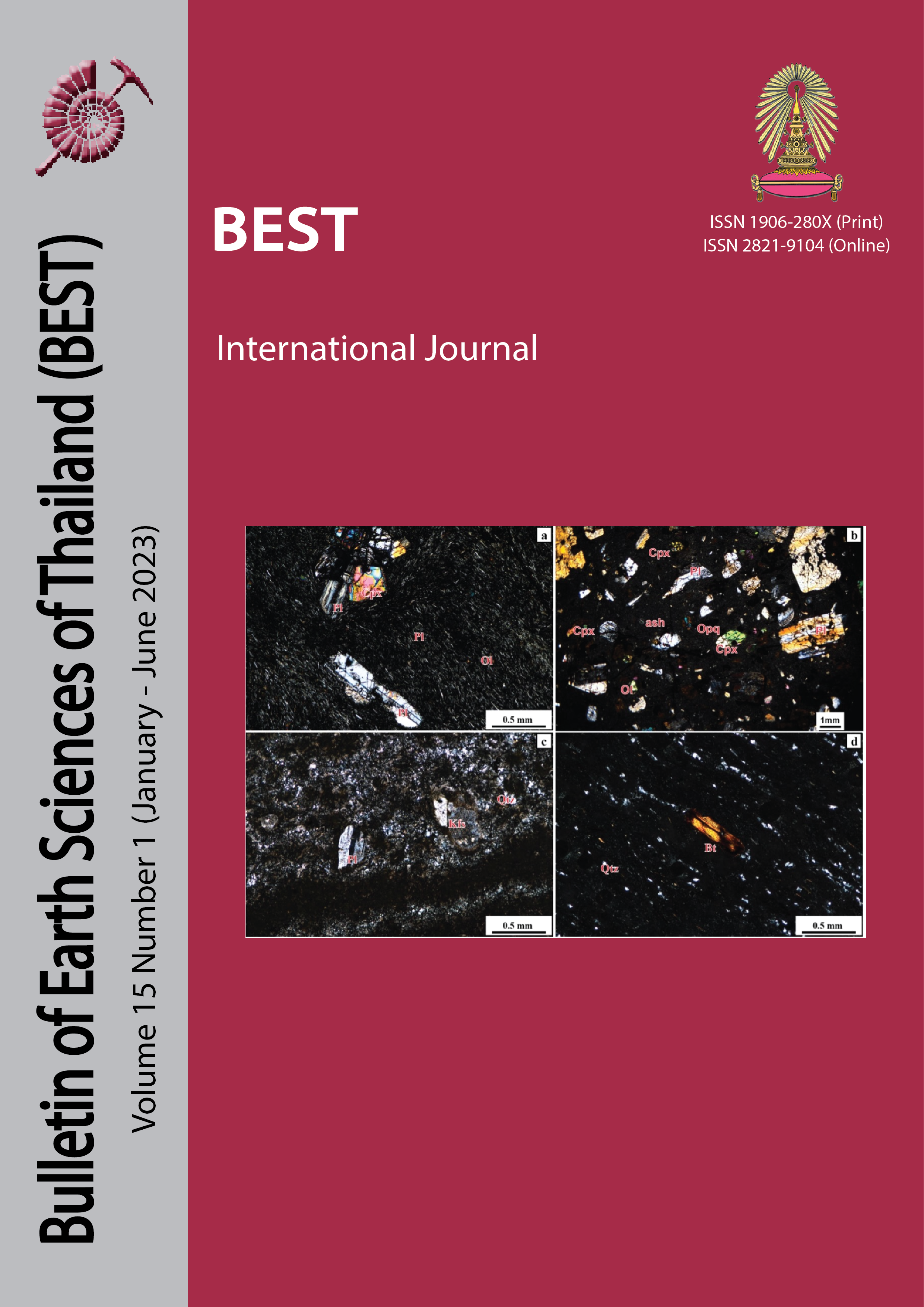Coastal multi-hazard assessment along the coast of Pranburi to Sam Roi Yot district, Prachuap Khiri Khan
Main Article Content
Abstract
The Pranburi-Sam Roi Yot coast in Prachuap Khiri Khan province contains various geomorphic features and land use types that are vulnerable to natural disasters such as storm surges and coastal erosion. This study assesses physical damage from multi-natural hazards by classifying physical indicators following the CHW method, which offers the hazard level in the studied area. As a result, the flood (storm surge) hazard is very high throughout most of the area, whereas the erosion hazard is very high in the TSR-coastal type and high in Pl-5-type. The hazards of saltwater intrusion and gradual inundation resulted in high intensity for both TSR and Pl-5 coastal types. Lastly, the hazard of ecosystem disruption is moderate in TSR and Pl-5 coastal types. Most land use categories in the research area were very high intensity for flooding concerns. Urban and agricultural land uses. The urban and agricultural land use categories are included at a high intensity level in the region with the greatest erosion threat. The geological setting parameter was a major factor in classifying the area as elevated danger for flooding and erosion. We suggest that additional criteria be examined in future studies to address indicators related to coastal damage. Natural hazard damage assessment may produce more accurate results.
Article Details

This work is licensed under a Creative Commons Attribution-NonCommercial-NoDerivatives 4.0 International License.
Copyright © 2008 Department of Geology, Faculty of Science, Chulalongkorn University. Parts of an article can be photocopied or reproduced without prior written permission from the author(s), but due acknowledgments should be stated or cited accordingly.
References
Appelquist, R.L., & Balstrøm, T. (2014). Application of The Coastal Hazard Wheel methodology for coastal multi-hazard assessment and management in the state of Djibouti. Climate Risk Management 3, pp 79–95.
Appelquist, R.L., & Balstrøm, T. (2015). Application of a new methodology for coastal multi-hazard-assessment & management on the state of Karnataka, India. Journal of Environmental Management 152, pp 1–10.
Appelquist, R.L., & Halsnæs, K. (2015). The Coastal Hazard Wheel system for coastal multi-hazard assessment and management in a changing climate. Journal of Coastal Conservation 19, pp 157-179.
Appelquist, L. R., Balstrøm, T., & Halsnæs, K. (2016). Managing climate change hazards in coastal areas: The Coastal Hazard Wheel decision-support system. United Nations Environment Programme: Nairobi, Kenya.
Bagdanavičiūtė, I., Kelpšaitė, L., & Soomere. T. (2015). Multi-criteria evaluation approach to coastal vulnerability index development in micro-tidal low-lying areas. Ocean & Coastal Management 104, pp 124–135.
Bilkovic, D.M., & Roggero, M.T. (2008). Effects of coastal development on nearshore estuarine nekton communities. Marine Ecology Progress Series 358, pp 27–39.
Denner, K., Phillips, M.R., Jenkins, R.E., & Thomas, T. (2015). A coastal vulnerability and environmental risk assessment of Loughor Estuary, South Wales. Ocean & Coastal Management 116, pp 478–490.
Department of Land Development. (2019). Din online: Soil information and land use services.https://dinonline.ldd.go.th/Default.aspx
Department of Mineral Resources. (2008). Segment classification for geological management and mineral resources Prachuap Khiri Khan Province. Bangkok
Department of Marine and Coastal Resources (2017). Data processing of coastal erosion situation in 2017 Prachuap Khiri Khan Province. https://www.dmcr.go.th/detailLib/3711
Department of Marine and Coastal Resources (2018). Marine and Coastal Resources Information Prachuap Khiri Khan Province. https://www.dmcr.go.th/detailLib/3760
Duriyapong, F., & Nakhapakorn, K. (2011). Coastal vulnerability assessment: a case study of Samut Sakhon coastal zone. Songklanakarin J. Sci. Technol. 33(4), 469-476
Gornitz, V. (1990) Vulnerability of the East Coast, USA to future sea level rise. J Coastal Res 9:201–237
Hydrographic Department, Royal Thai Navy. (2022). highest and lowest water level of 2022.http://www.hydro.navy.mi.th/servicestide.html
IPCC, (2022). Climate Change 2022: the IPCC 6th Assessment Report. https://www.ipcc.ch
Kantamaneni, K. (2016). Counting the cost of coastal vulnerability. Ocean & Coastal Management. 132, pp 155–169.
Manno, G., Re, L.C., Basile, M., & Ciraolo, G. (2022). A new shoreline change assessment approach for erosion management strategies. Ocean & Coastal Management 225, p 106226.
McLanghlin, S., McKenna, J., Cooper, J.A.G. (2002). Socio-economic data in coastal vulnerability indices: constraints and opportunities. Journal of Coastal Research 36, pp 487–497
Micallef, S., Micallef, A., Galdies, C. (2018). Application of the Coastal Hazard Wheel to assess erosion on the Maltese coast. Ocean & Coastal Management 156, pp 209–222.
Mohd, F.A., Abdul Maulud, K.N., Karim, O.A., Begum, R.A., Awang, N.A., Anizawati, A., et al. (2019). Comprehensive coastal vulnerability assessment and adaptation for Cherating-Pekan coast, Pahang, Malaysia. Ocean & Coastal Management 182.
Nunez, K., Rudnicky, T., Mason, P., Tombleson, C., & Berman, M. (2022). A geospatial modeling approach to assess site suitability of living shorelines and emphasize best shoreline management practices. Ecological Engineering 179, p 106617.
Palmer. B., et al (2011) Preliminary coastal vulnerability assessment for KwaZulu-Natal, South Africa. J Coastal Res 1390.
Paul, S., & Das, S.C. (2021). Delineating the coastal vulnerability using Coastal Hazard Wheel: A study of West Bengal coast, India. Regional Studies in Marine Science 44, p 101794.
Ramieri, E., Hartley, A., Barbanti, A., Santos, F.D., Gomes, A., Hilden, M., Laihonen, P., Marinova, N., Santini, M., 2011 Method for assessment coastal vulnerability to climate change in: European Topic Centre on climate change impacts, Vulnerability and Adaptation. European Environment Agency.


